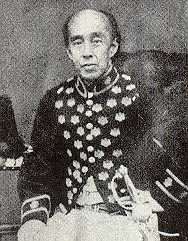Makino Tadayuki
| Makino Tadayuki | |
|---|---|
 Makino Tadayuki | |
| 11th Lord of Nagaoka | |
|
In office 1858–1867 | |
| Preceded by | Makino Tadamasa |
| Succeeded by | Makino Tadakuni |
| 54th Kyoto Shoshidai | |
|
In office 1862–1863 | |
| Preceded by | Matsudaira Munehide |
| Succeeded by | Inaba Masakuni |
| Rōjū | |
|
In office 1863–1865 | |
| Personal details | |
| Born |
October 22, 1824 Edo, Japan |
| Died | September 1, 1878 (aged 53) |
| Nationality | Japanese |
Makino Tadayuki (牧野 忠恭, October 22, 1824 – September 1, 1878) was a Japanese daimyo of the late Edo period.[1]
The Makino were identified as one of the fudai or insider daimyō clans which were hereditary vassels or allies of the Tokugawa clan, in contrast with the tozama or outsider clans.[2]
Makino clan genealogy
The fudai Makino clan originated in 16th century Mikawa province. Their elevation in status by Toyotomi Hideyoshi dates from 1588.[2] They claim descent from Takechiuchi no Sukune,[3] who was a legendary Statesman[4] and lover of the legendary Empress Jingu.[5]
Tadayuki was part of the senior branch of the Makino which was established at Tako Domain in Kōzuke province in 1590; and in 1616, their holdings were moved to Nagamine Domain in Echigo province. From 1618 through 1868, this branch of the Makino remained at Nagaoka Domain (74,000 koku) in Echigo province.[3]
Tadayuki was the 11th-generation head of this senior line of the Makino.
The head of this clan line was ennobled as a "Viscount" in the Meiji period.[3]
Tokugawa official
Tadayuki served in the Tokugawa Shogunate as a rōjū. He was the shogunates's fifty-fifth Kyoto shoshidai in the period spanning September 17, 1862 through July 26, 1863.[1]
During the Boshin War of 1868-1869, the forces from Nagaoka Han fought against Meiji government forces. In this period, Tsuginosuke Kawai (1827–1868), was the military general of the Makino Clan; and today the Tsuginosuke Kawai Memorial Hall is sited in Naga-chô where Kawai’s residence once stood. When Meiji forces took Nagaoka, Kawai withdrew towards Aizu and Sendai along with Makino Tadayuki and other fleeing clan leaders.[6]
Tadayuki died in Tokyo in 1878, and is buried at Saikai-ji Temple.
Notes
- 1 2 Meyer, Eva-Maria. "Gouverneure von Kyôto in der Edo-Zeit." Universität Tübingen (in German).
- 1 2 Alpert, Georges. (1888). Ancien Japon, p. 70.
- 1 2 3 Papinot, Jacques. (2003) Nobiliare du Japon -- Makino, p. 29; Papinot, Jacques Edmond Joseph. (1906). Dictionnaire d’histoire et de géographie du Japon. (in French/German).
- ↑ Brasch, Kurt. (1872). "Japanischer Volksglaube," Mitteilungen der deutschen Gesellschaft für Natur- und Völkerkunde Ostasiens, p. 56. (in German)
- ↑ Guth, Christine. "Book Revies: Japan's Hidden History: Korean Impact on Japanese Culture by Jon Carter Covell and Alan Covell," Numen. 33:1, 178-179 (June 1986).
- ↑ "A New Historic Landmark: The Tsuginosuke Kawai Memorial Hall," Konichiwa Nagaoka, Vol. 188 (January 2007), p. 2.
References
- Appert, Georges and H. Kinoshita. (1888). Ancien Japon. Tokyo: Imprimerie Kokubunsha.
- Meyer, Eva-Maria. (1999). Japans Kaiserhof in de Edo-Zeit: Unter besonderer Berücksichtigung der Jahre 1846 bis 1867. Münster: Tagenbuch. ISBN 3-8258-3939-7
- Papinot, Jacques Edmund Joseph. (1906) Dictionnaire d'histoire et de géographie du japon. Tokyo: Librarie Sansaisha...Click link for digitized 1906 Nobiliaire du japon (2003)
- Sasaki Suguru. (2002). Boshin sensō: haisha no Meiji ishin. Tokyo: Chūōkōron-shinsha.
External links
- National Archives of Japan ... Nagaoka Castle (1644)
| Preceded by Makino Tadamasa |
11th Lord of Nagaoka 1858-1867 |
Succeeded by Makino Tadakuni |
| Preceded by Matsudaira Munehide |
54th Kyoto Shoshidai 1862-1863 |
Succeeded by Inaba Masakuni |